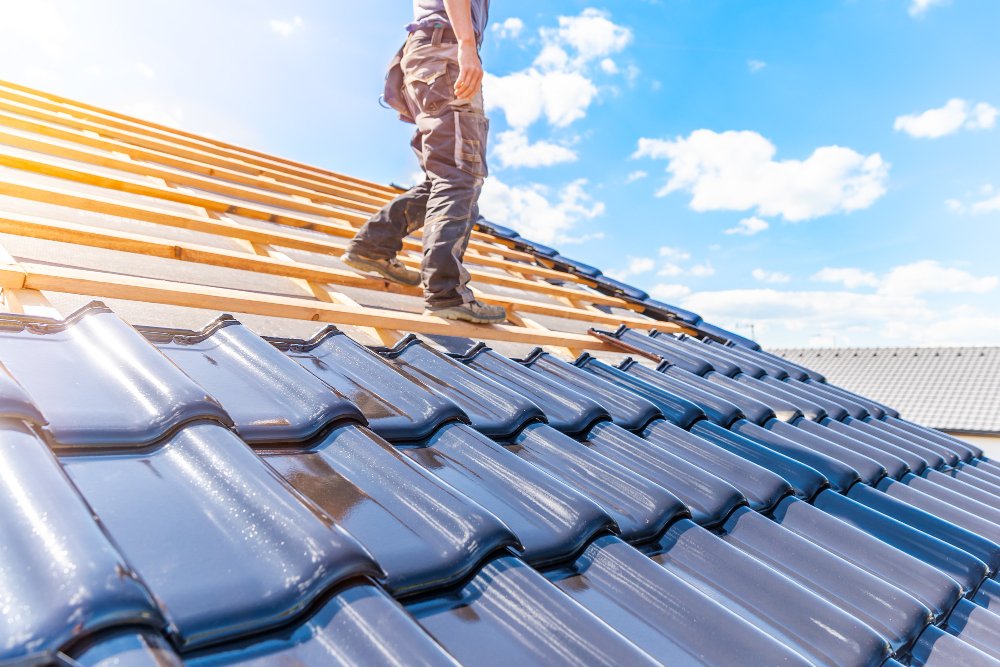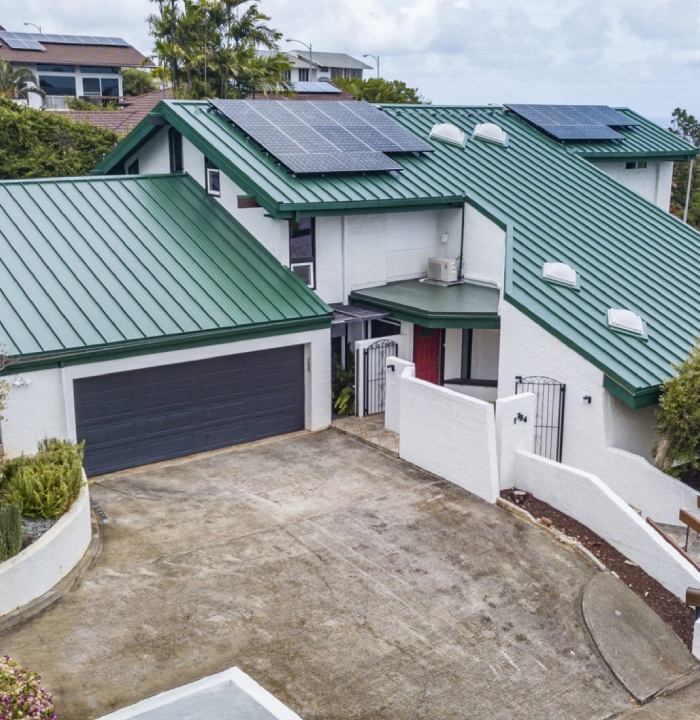Navigating Roofing Trends: What's New in honolulu roofing materials
The Ultimate Checklist for Roof Install: Guaranteeing Top Quality and Resilience
The procedure of installing a roofing requires mindful focus to information. A complete list can aid assure quality and resilience throughout the project. From examining the existing roofing condition to picking the ideal materials, each step is crucial. Proper prep work and devices play a vital role in achieving a successful setup. Nevertheless, many forget the importance of final assessments and recurring maintenance. Recognizing these components can significantly affect the long life of a brand-new roof covering.
Examining Your Current Roofing System Condition
Exactly how can one effectively establish the condition of their current roofing? A complete evaluation is necessary for evaluating a roof covering's stability. Property owners should begin by analyzing the roofing system from the ground, seeking visible signs of wear such as missing out on tiles, drooping areas, or discoloration. Closer assessment can be done by accessing the roofing system itself, where one need to examine for split or crinkled tiles and evaluate blinking around vents and chimneys.Additionally, the interior of the home warrants attention; water discolorations or mold growth on ceilings and wall surfaces might indicate leakages. Attic assessments can expose possible issues, such as poor air flow or signs of moisture.Regular evaluations, ideally twice a year, can help determine troubles early and stop pricey repair work. By understanding the roof's present state, homeowners can make informed decisions around necessary maintenance or substitutes.
Picking the Right Roof Covering Materials
When selecting roof covering materials, what factors should homeowners consider to assure a resilient and effective selection? Initially, the climate plays a substantial role; materials should stand up to local weather condition problems, whether it's heavy rain, snow, or intense sun. Next off, the long life of the product is important; choices like metal or slate deal expanded life expectancies contrasted to asphalt tiles. Home owners must likewise evaluate the product's weight, as this can affect the structural integrity of the home. Additionally, visual appeals matter; the chosen material should complement the general architectural design. Power performance is an additional factor to consider; some materials show heat, decreasing air conditioning expenses. Spending plan constraints will dictate selections; while some materials might have a lower upfront cost, lasting durability can lead to greater cost savings. By weighing these variables, homeowners can make educated choices that boost their roof covering's quality and longevity.
Getting ready for Setup
Prior to the installation process starts, property owners must assure that their home is adequately prepared to suit the brand-new roofing. This prep work involves several essential steps to assure a smooth and efficient installation. Homeowners ought to remove the location around the residence of any type of debris, devices, or furniture that could impede accessibility for service providers. Furthermore, it is essential to notify neighbors about the future work to lessen interruption and secure cooperation.Next, house owners ought to evaluate their existing roofing and architectural parts, addressing any potential concerns such as rotting wood or leaks that might affect the installation. Protecting essential authorizations and adhering to local structure codes is essential for compliance and safety and security. Lastly, arranging the installation during desirable weather problems assists prevent hold-ups and warranties that the work earnings without difficulties. Proper preparation sets the structure for a successful roof job, ultimately improving the long life and effectiveness of the new roofing.

Vital Tools and Tools
In roofing setup, having the right devices and tools is crucial for a successful project. This consists of crucial security gear, different roofing installment tools, and reliable material managing devices. Proper preparation and selection of these things can greatly improve efficiency and security on duty website.
Security Gear Requirements
Security equipment is a necessary part of any roofing system installation job, making certain the wellness of workers at elevated elevations. Essential safety and security devices includes hard hats, which protect versus dropping debris, and security goggles to protect the eyes from dirt and particles. Non-slip footwear is significant for preserving grip on high surfaces, while harnesses and lanyards give loss defense, avoiding significant injuries. Handwear covers help secure hands from sharp products and minimize fatigue during extended durations of job. Additionally, high-visibility vests boost presence, advertising recognition amongst team members and nearby workers. The usage of ear defense may additionally be advisable in noisy environments. In general, sticking to safety equipment needs is crucial for a safe and efficient roofing setup procedure.

Roof Covering Installment Devices
Appropriate safety measures prepared for a successful roof covering job, however having the right devices and devices is equally vital. Important tools for roof covering installation include a ladder, enabling safe accessibility to the roofing, and a roof covering nail gun to ensure efficient and protected fastening of products. A chalk line is essential for marking straight lines, while an utility blade is necessary for cutting roofing materials precisely. Additionally, a lever help in removing old roof shingles. Employees ought to also have a level to validate appropriate placement and drainage. Ultimately, a good set of work handwear covers shields hands while giving hold. With each other, these devices help with a smooth roof procedure, improving both top quality and longevity.
Product Handling Equipment

A variety of material handling equipment is vital for an effective roofing installation procedure. Tools such as forklifts, lifts, and dollies facilitate the activity of heavy products like roof shingles and underlayment to the task site and onto the roof. Using scaffolding and ladders warranties risk-free access to elevated areas while lessening the danger of injury. Tarps and containers are necessary for proper storage and company of materials, stopping damages and guaranteeing very easy retrieval. Additionally, a crane might be needed for larger roof covering jobs to raise substantial products straight onto the roof covering. Appropriate training being used this tools is necessary; it improves operations efficiency and contributes to total project safety, ensuring a successful roof covering installation.
Step-by-Step Setup Process
The step-by-step installment procedure is vital for an effective roof covering installment. It begins with preparing the roof surface, followed by the correct installation of underlayment, and wraps up with the efficient protecting of roofing materials. Each of these actions plays an essential function in making certain the toughness and capability of the roof covering.
Prepare the Roof Surface
Preparing the roof covering surface is essential for guaranteeing an effective installment of roof materials. This process starts with a comprehensive examination to determine any kind of existing damage or debris. Any kind of loose roof shingles, sticking out nails, or old roof materials must be eliminated to create a clean, smooth structure. Next off, the roofing deck need to be checked for rot or architectural problems, as these can endanger the integrity of the brand-new roofing. After repairs, an extensive cleansing is required; this consists of sweeping away dirt, leaves, visite site and any other contaminants that might prevent bond. Making certain appropriate drainage and ventilation is vital, as these aspects influence the longevity of the roof. A well-prepared surface area establishes the phase for suitable setup and durability.
Install Underlayment Correctly
Setting up underlayment properly is essential for improving the overall efficiency of the roof. The procedure starts with picking the ideal underlayment material, which can include really felt, synthetic, or rubberized alternatives. Next, validate the roof covering surface area is tidy and dry before laying the underlayment - honolulu roofing materials. Begin at the most affordable point of the roofing, rolling out the underlayment flat and overlapping each row by at least 6 inches. It is necessary to protect the underlayment in position with staples or roof nails, avoiding voids or creases that could compromise water resistance. Lastly, trim excess material at the sides, assuring a cool coating. This thorough installation step is crucial for supplying an added layer of defense versus wetness and boosting durability
Secure Roofing Products Efficiently
After confirming the underlayment is right here effectively set up, the following action includes safeguarding the roof covering materials successfully. The roofing specialist must collect all necessary products, including tiles, nails, and blinking. Beginning at the lowest factor of the roofing, tiles need to be laid in a staggered pattern, confirming proper overlap to stop leaks. Each shingle needs to be fastened with nails, utilizing the maker's advised spacing and quantity. It is vital to drive nails straight, preventing over-penetration, which can compromise the material. Blinking need to be installed around chimneys and vents to enhance waterproofing. Finally, the specialist needs to conduct an extensive inspection to confirm all materials are safely secured, as this will greatly influence the roofing system's general resilience and durability.
Performing Final Examinations
Detailed final assessments are necessary to ensure that a freshly installed roofing satisfies all safety and high quality standards. This important action entails examining the entire roof for any potential problems that may develop post-installation. Inspectors must examine the alignment of tiles, making specific they are properly safeguarded and free from problems. Blinking and air flow systems need to additionally be examined for correct installation and functionality.Additionally, the inspector should check seamless gutters and downspouts to confirm they are suitably positioned to facilitate water drainage. Any indicators of leakages, misaligned products, or insufficient securing around penetrations need to be dealt with right away. Contractors ought to additionally make sure that all debris from the setup procedure is eliminated, leaving the website clean and risk-free. Carrying out these comprehensive evaluations aids prevent future difficulties, eventually extending the life-span of the roofing system and giving property owners with tranquility of mind concerning their financial investment.
Maintaining Your New Roof
Appropriate maintenance is vital for guaranteeing the longevity and performance of a new roofing system. Home owners ought to perform routine examinations at the very least twice a year, preferably in spring and loss, to recognize possible issues early. During these assessments, they must search for indications of damage, such as missing out on shingles, leakages, or particles buildup, which can hinder drain and advertise mold and mildew growth.Cleaning rain gutters and downspouts is necessary, as clogged systems can cause water damage and structural problems. Furthermore, trimming looming branches can prevent abrasion and particles accumulation on the roof surface.It's also suggested to set up specialist examinations every few years to evaluate the roof covering's problem extensively. Keeping records of upkeep activities and repair work can aid track the roof covering's performance over time (honolulu roofing contractor). By sticking to a constant upkeep regimen, homeowners can shield their financial investment and guarantee their new roof remains effective for years to come
Regularly Asked Questions
The length of time Does a Typical Roof Setup Take?
The duration of a normal roof installation varies based upon elements such as roofing dimension, materials, and weather. Generally, it can take anywhere from someday to a number of weeks to finish the installation.
Can I Mount a New Roof Covering Over an Existing One?
The inquiry of installing a new roof over an existing one usually emerges. Lots of property owners consider this alternative for cost-effectiveness, yet it is important to review local building regulations and the architectural stability of the existing roof.
What Allows Are Needed for Roof Covering Setup?
Prior to setting up a roofing, one must examine regional regulations. Normally, building permits are called for, in addition to examinations to ensure conformity with security requirements and zoning link legislations. Consulting with local authorities is essential for correct assistance.
What Warranties Are Offered for Roof Covering Products?
Various warranties exist for roofing materials, usually consisting of supplier guarantees covering flaws and efficiency. In addition, some contractors use workmanship warranties, making certain setup top quality. Purchasers ought to meticulously evaluate terms to comprehend protection duration and restrictions.
How Can Weather Condition Impact the Setup Refine?
Weather considerably influences the installation procedure, as rain, snow, or severe temperatures can postpone job, affect product adhesion, and concession security. Proper preparation and scheduling around weather report are vital for successful roof covering installation.